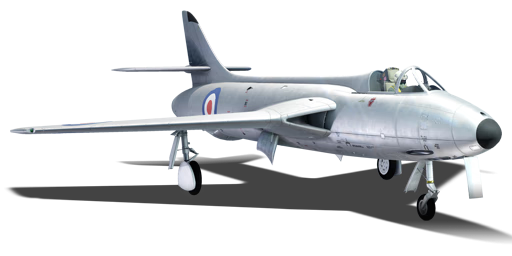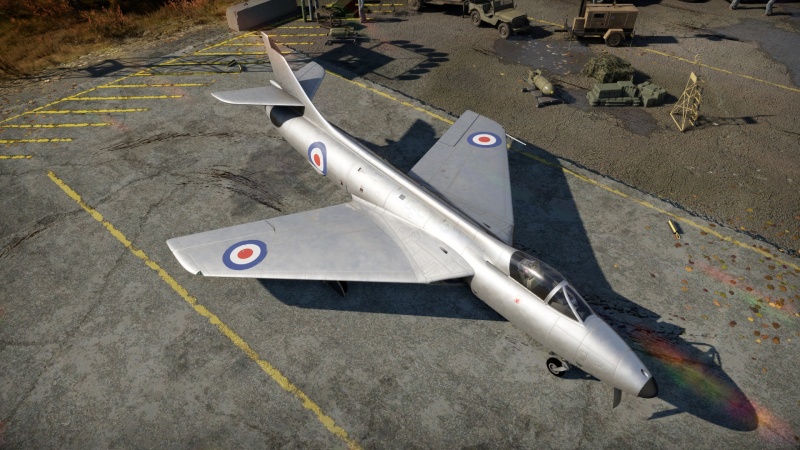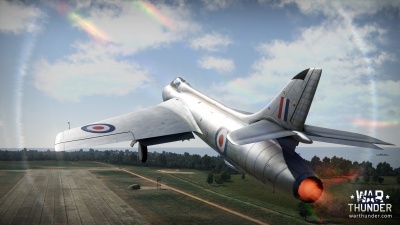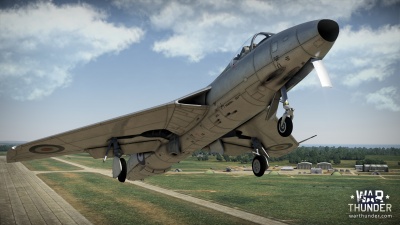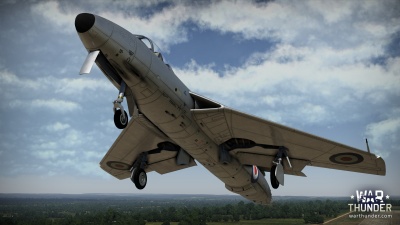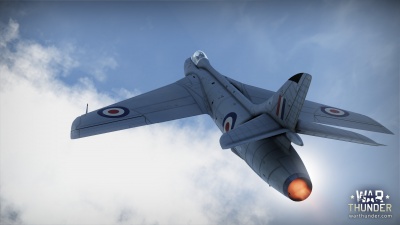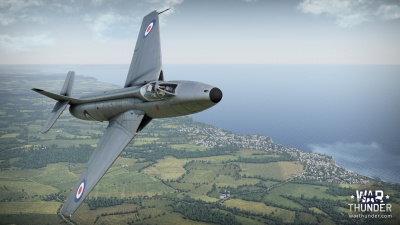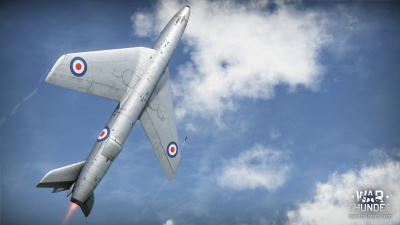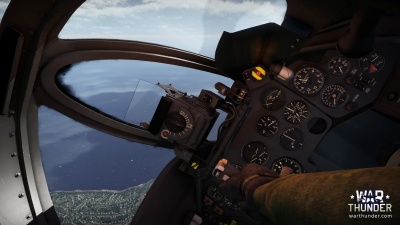Hunter F.1
| This page is about the British jet fighter Hunter F.1. For other versions, see Hunter (Family). |
Contents
Description
Following the end of WWII, a new British government decided to focus their efforts into rebuilding the nation, under the assumption that another major conflict would not occur for at least a decade. During this time, Air Ministry Specifications were primarily issued for research designs, rather than any military requirements. As a result, at the dawn of the Cold War in the late 1940s, the RAF quickly realised that it was lagging behind in aerial capabilities, and pressed for the development of new fighter aircraft with the latest features, such as swept wings. Alongside the Supermarine Swift, one design that garnered particular interest was the Hawker Hunter. While initially developed as a swept-wing version of the Hawker Sea Hawk, it underwent a number of improvements including replacement of the two Rolls-Royce Nene engines with a single copy of the new, prototype Rolls-Royce Avon engine, which was thinner but also significantly more powerful. The prototype took its first flight in July 1951, and entered service with the RAF in July 1954, replacing the Gloster Meteors, de Havilland Venoms, imported Canadair Sabres, and the Supermarine Swift. Despite initial teething problems with the new engine and airframe, the Hawker Hunter became one of the most successful British post-war jet designs, with almost 2,000 aircraft manufactured in more than 60 variants, and exported to over 20 countries. The final Hunters were finally withdrawn from service with the Lebanese Air Force in 2014.
Introduced in Update 1.53 "Firestorm", the Hunter F.1 is a drastic departure from the playstyles of the jets and props that precede it. Its calling card is its high top speed, coupled with excellent high-speed manoeuvrability and a complement of four powerful 30 mm ADEN cannons on a relatively stable platform, allowing it to swoop in and make short work of unsuspecting opponents, before quickly evacuating from danger. While its low-speed flight characteristics are subpar, maintaining at least 800 km/h at all times will allow the Hunter to fight toe-to-toe with common opponents such as F-86 Sabres and MiG-17s; however, extra care should be taken when facing supersonic opponents and those equipped with air-to-air guided missiles.
General info
Flight performance
The Hawker Hunter is a transonic jet fighter, powered by the Rolls-Royce Avon Mk.113 engine. It is able to reach 1,109 km/h at sea level and 1,013 km/h at 9,000 m, very similar to the F-86F series. It can reach 1.0 Mach in dive and be able to recover from it. Its thrust to weight ratio is 0.50 with fuel tanks and 0.57 with 5 minutes of fuel, making the level acceleration very good. The climb rate is also good, 55 m/s at sea level, but in order to achieve it the Hunter needs to keep 920 km/h TAS, it is better in comparison to other jets without an afterburner like a F-86F or MiG-17. The engine might start overheating after 10 minutes of flying at 100%, which can be mitigated by setting RPM to 7,550 or lower.
Despite having low wing loading compared to other jets it is not particularly manoeuvrable and has a high stall speed, due to the low amount of lift generated by its wings. While its high speed turn rate is decent and the plane can pull up to ~12 G, once the plane decreases its speed to around 700 km/h it begins to struggle and it only gets worse the slower it flies. Outturning any Sabre or MiG-15 is not possible and the plane will have a hard time even against planes like the F11F-1. The elevator starts to lock up above 0.85 Mach, below that speed it should be able to pull at least 11G. Its roll rate is decent and just good enough to make flying it comfortable, ~120°/s at 900 km/h, ~105°/s at 600 km/h and ~50°/s at 300 km/h, making it better than the MiG-15bis or MiG-17, but worse than all American Sabres. The flaps can slightly improve the turning performance, however they can only be used below 600 km/h IAS, where it struggles to turn. The airbrake provides as much drag as in similar planes like the Sabre, but has one issue, it is located under the plane, so it cannot be deployed when the landing gear is extended. This can make landing quite tricky since its wheel brakes are also weak and landing speed is high: around 300 km/h IAS with flaps.
The Hunter is a very nice to fly plane in both Realistic and Simulator battles, aiming is easy since it is very stable. A slight pitch trimming might be required to stop its nose from dropping, up to 3%. Reaching the maximum angle of attack will not make it start spinning immediately, that can happen only after a few seconds pulling it all the way to yourself, but it also can be easily recovered from that state.
| Characteristics | Max Speed (km/h at 0 m - sea level) |
Max altitude (metres) |
Turn time (seconds) |
Rate of climb (metres/second) |
Take-off run (metres) | |||
|---|---|---|---|---|---|---|---|---|
| AB | RB | AB | RB | AB | RB | |||
| Stock | 1,098 | 1,092 | 14000 | 32.0 | 33.3 | 44.6 | 40.7 | 820 |
| Upgraded | 1,117 | 1,108 | 30.1 | 31.0 | 65.8 | 55.0 | ||
Details
| Features | |||||
|---|---|---|---|---|---|
| Combat flaps | Take-off flaps | Landing flaps | Air brakes | Arrestor gear | Drogue chute |
| ✓ | ✓ | ✓ | ✓ | X | X |
| Limits | ||||||
|---|---|---|---|---|---|---|
| Wings (km/h) | Gear (km/h) | Flaps (km/h) | Max Static G | |||
| Combat | Take-off | Landing | + | - | ||
| 1,193 | 450 | 603 | 581 | 465 | ~12 | ~5 |
| Optimal velocities (km/h) | |||
|---|---|---|---|
| Ailerons | Rudder | Elevators | Radiator |
| < 850 | < 600 | < 650 | N/A |
Engine performance
| Engine | Aircraft mass | ||||
|---|---|---|---|---|---|
| Engine name | Number | Basic mass | Wing loading (full fuel) | ||
| Rolls-Royce Avon Mk.113 | 1 | 6,069 kg | 230 kg/m2 | ||
| Engine characteristics | Mass with fuel (no weapons load) | Max Takeoff Weight | |||
| Weight (each) | Type | 5m fuel | 16m fuel | ||
| 1,175 kg | Axial-flow turbojet | 6,426 kg | 7,259 kg | 9,530 kg | |
| Maximum engine thrust @ 0 m (RB/SB) | Thrust to weight ratio @ 0 m (100%) | ||||
| Condition | 100% | WEP | 5m fuel | 16m fuel | MTOW |
| Stationary | 3,283 kgf | N/A | 0.51 | 0.45 | 0.34 |
| Optimal | 3,631 kgf (1,193 km/h) |
N/A | 0.57 | 0.50 | 0.38 |
Survivability and armour
- 64 mm Bulletproof glass - Armoured windscreen
- 12.7 mm Steel - Armour plate behind the pilot
Modifications and economy
Armaments
Offensive armament
The Hunter F.1 is armed with:
- 4 x 30 mm ADEN cannons, chin-mounted (150 rpg = 600 total)
Usage in battles
The Hunter's main strengths are high top speed and good guns, making it a good Boom & Zoomer.
The Hunter is less manoeuvrable than the F-86 and MiG-15 while being the second fastest with a good thrust-to-weight ratio. However, the rate of climb is significantly worse than the other jets and so it requires some side climbing. Stay fast at all times and never drop beneath 850 TAS (~800 km/h in air).
The 30 mm ADEN cannon is an extremely powerful cannon. Being a revolver cannon, it fires extremely fast and has excellent ballistics. The Hunter F.1 has, thanks to mounting a pack of four ADEN 30 mm cannons, one of the highest one-second burst masses, near 21 kg/s. This weapon's characteristics mean that the 4 of them pose a serious threat for any aircraft that happens to be the target of them. The cannon, however, has the disadvantage of chewing very quickly through ammo thanks to its high rate of fire, so being wary of the ammo count is a necessity. The discrete tracer rounds may induce the player into error, causing the impression that only a light burst is being fired, however experience will quickly disprove anyone who thinks in this manner.
The armour-piercing rounds of the Hunter enable it to do some ground attack against light tanks, medium tanks, and pillboxes.
Radars
The Hunter F.1 is equipped with an ARI.5820 rangefinding radar, located in the nose of the aircraft. It will automatically detect other planes within the scanning area and display the range to the closest target. It is linked with a gyro gunsight and can help with aiming at close range.
| ARI.5820 - Rangefinding radar | |||
|---|---|---|---|
| Maximum Tracking Range |
Minimum Tracking Range |
Azimuth Tracking Angle |
Elevation Tracking Angle |
| 2,750 m | 300 m | ±9° | ±9° |
Pros and cons
Pros:
- Decent acceleration above 900 km/h
- Large and effective air brake
- Insanely good armament; four rapid-firing 30 mm ADEN cannons shred everything in a short burst
- Very good energy retention; does not lock easily
- Can out zoom climb MiG-17s and MiG-15bis
- Can outrun most contemporary jets on your six if put into a 10° climb
- Armament is capable of destroying tanks and light pillboxes
- New boosters modification allows it to make deflection shots at high speeds
- Very stable, makes aiming at any speed easy
Cons:
- Most jets in uptiers can out-speed, use afterburner, out-turn the Hunter, or rely on their air-to-air missiles
- AAMs (even AIM-9Bs and R-3Ss) nullify your speed advantage and force the Hunter to bleed speed to avoid them
- Nearly all supersonic jets will be very hard to face
- Doesn't have air-to-air missiles
- Worst jet in terms of 1 vs 1 due to the bad manoeuvrability; it will be left in desperation when the rest of the team is gone
- Poor performance in horizontal turning; must rely on the speed advantage
- Very large target, especially when turning
History
In the aftermath of the second world war the Air Ministry issued Specification E.38/46 for a swept wing research aircraft that was fulfilled by a modified Hawker Sea Hawk (P.1052). The experimental aircraft showed an jump in high speed performance and as a result Hawker went forward to modify the second P.1052 into the P.1081. With a swept tail plane and the engine exhaust now located at the rear of the fuselage instead of the split exhaust further improving performance, it attracted the RAAF. The P.1081 gave Hawker useful information for the development of the Hunter.
In 1946 the Air Ministry issued Specification F.43/46 that was later added to in 1948 by Specification F.3/48. This demanded a speed of 629 mph at 45,000 ft and a high rate of climb (as F.43/46 was for a jet powered interceptor), while carrying an armament of four 20 mm or two 30 mm cannons. Using what they had learnt from the P.1052 and P.1081 they produced the Prototype P.1067. The new prototype first flew with the Avon 103 engine in 1951 with a second powered by the Avon 107 in 1952.The Air Ministry ordered the Hunter into production in 1950 with the Avon 113 power plant. Thus the iconic Hawker Hunter was born.
The first production or pre-production F.1s entered service in 1953. The first was WT556 that entered service with A&AEE on the 16th of July 1953 and a further 15 delivered the same year. The Early F.1's featured boosted control surfaces but not the under belly air brake. The armament consisted of four 30 mm ADEN cannons with 150 rpg at 1200 rpm located under the nose.
Media
- Skins
- Images
- Hunter F.1 Devblog Images
- Videos
See also
- Related development
- Hawker Sea Hawk
- Aircraft of comparable role, configuration and era
- Dassault Super Mystère
- Mikoyan MiG-17
- North American F-100 Super Sabre
- North American FJ-4B Fury
External links
- [Devblog] Yak-9B and Hawker Hunter F.1
- Official data sheet - more details about the performance
- Hawker Hunter F.1 forum thread
| Hawker Aircraft Limited | |
|---|---|
| Biplane fighters | |
| Fury | Fury Mk I · Fury Mk II |
| Nimrod | Nimrod Mk I · Nimrod Mk II |
| Scout plane | Osprey Mk IV |
| Piston fighters | |
| Hurricane | Hurricane Mk I/L · Hurricane Mk.I/L FAA M · Sea Hurricane Mk IB · Sea Hurricane Mk IC · Hurricane Mk IIB/Trop · Hurricane Mk IV |
| Typhoon | Typhoon Mk Ia · Typhoon Mk Ib · Typhoon Mk Ib/L |
| Tempest | Tempest Mk V · Tempest Mk V (Vickers P) · Tempest Mk II |
| Fury | Sea Fury FB 11 |
| Jet fighters | |
| Hunter | Hunter F.1 · Hunter F.6 · Hunter FGA.9 |
| Sea Hawk | Sea Hawk FGA.6 |
| Harrier | Harrier GR.1 · Harrier GR.3 |
| Export | ▄Hurricane Mk I/L · ▂Hurricane Mk IIB · ◘Sea Fury FB 51 |
| ◘Sea Hawk Mk.50 · ◄Sea Hawk Mk.100 · ◘Hunter F.6 · ◌Hunter F.58 · J34 · AV-8A · AV-8C · ▄AV-8S | |
| Captured | ▀Tempest Mk V |
| See Also | Fokker |
| Britain jet aircraft | |
|---|---|
| Blackburn | Buccaneer S.1 · Buccaneer S.2 · Buccaneer S.2B |
| British Aerospace | Harrier GR.7 · Sea Harrier FRS.1 (e) · Sea Harrier FRS.1 · Sea Harrier FA 2 |
| British Aircraft Corporation | Strikemaster Mk.88 |
| English Electric | Canberra B Mk 2 · Canberra B (I) Mk 6 · Lightning F.6 · Lightning F.53 |
| Gloster | Meteor F Mk 3 · Sea Meteor F Mk 3 · Meteor F Mk 4 G.41F · Meteor F Mk 4 G.41G · Meteor F Mk 8 G.41K · Meteor F Mk.8 Reaper |
| Javelin F.(A.W.) Mk.9 | |
| de Havilland | Vampire F.B.5 · Venom FB.4 · Sea Venom FAW 20 · Sea Vixen F.A.W. Mk.2 |
| Hawker | Sea Hawk FGA.6 · Hunter F.1 · Hunter F.6 · Hunter FGA.9 · Harrier GR.1 · Harrier GR.3 |
| Panavia | Tornado GR.1 · Tornado GR.4 · Tornado F.3 · Tornado F.3 Late |
| SEPECAT | Jaguar GR.1 · Jaguar GR.1A · Jaguar IS |
| Supermarine | Attacker FB 1 · Attacker FB.2 · Scimitar F Mk.1 · Swift F.1 · Swift F.7 |
| Foreign | Phantom FG.1 (USA) · Phantom FGR.2 (USA) · F-4J(UK) Phantom II (USA) |
| Australia | F-111C |
| India | ▄MiG-21 Bison |
| South Africa | ▄JAS39C |


